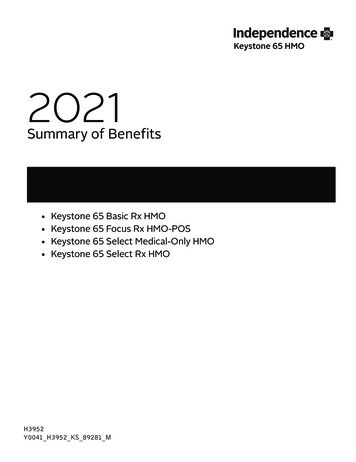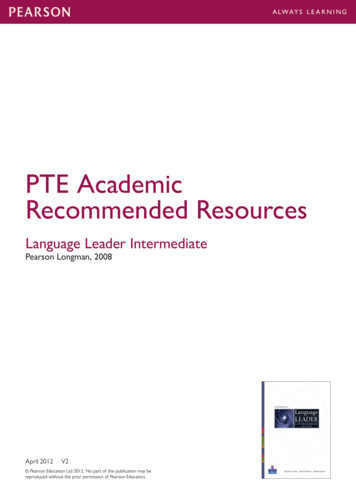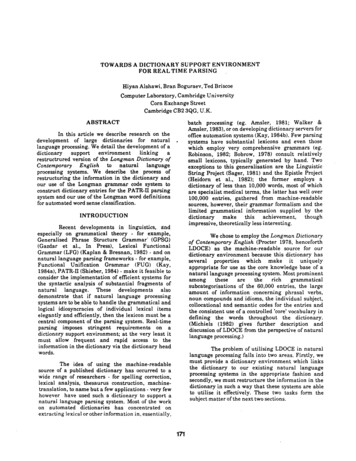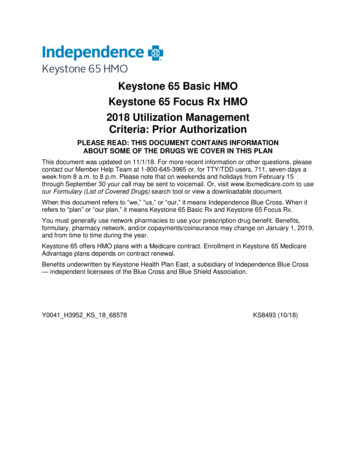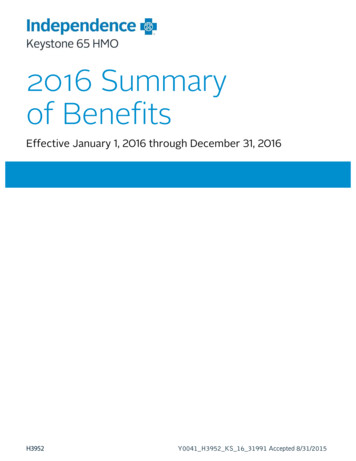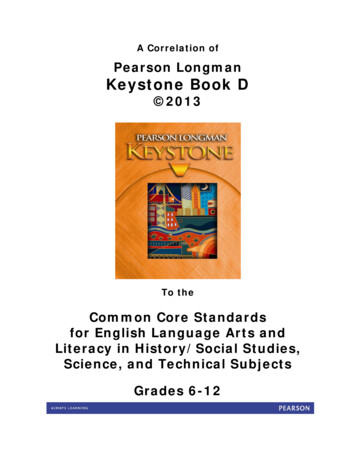
Transcription
A Correlation ofPearson LongmanKeystone Book D 2013To theCommon Core Standardsfor English Language Arts andLiteracy in History/Social Studies,Science, and Technical SubjectsGrades 6-12
IntroductionThis document demonstrates how Pearson Longman Keystone, Book D aligns to theCommon Core State Standards for English Language Arts and Literacy in History/SocialStudies, Science, and Technical Subjects.Pearson Longman Keystone is a Grades 6-12 eight-level flexible program designed forEnglish learners and struggling readers whose academic achievement is two or more yearsbelow grade level. Through explicit, intensive, and focused instruction that acceleratesstudents' language acquisition, reading comprehension, vocabulary, and oral and writtencommunication skills, students will quickly begin achieving academic success and be betterprepared to transition to mainstream coursework across the curriculum.Pearson Longman Keystone blends rigorous, research-based reading and language skillsinstruction together with a balance of content-area readings and age-appropriate, highinterest literature. In addition, this series incorporates the focused and purposefulinstructional principles of Understanding by Design, which allow students to demonstratetheir understanding and mastery of skills through multiple formal and informal assessmentopportunities. Through this process, students will be equipped with the key transferableacademic skills necessary for lifelong success.Program Highlights Six thematic units per level are organized around a Big QuestionCritical academic vocabulary and key words are explicitly taught before each readingConnected learning opportunities allow students to demonstrate their mastery of theskills coveredWell-organized instructional support provides a clearly defined roadmap ofinstruction
Table of ContentsCommon Core Standards for English Language Arts, Grade 6 . 4Common Core Standards for English Language Arts, Grade 7 . 20Common Core Standards for English Language Arts, Grade 8 . 36Common Core Standards for Literacy in History/Social Studies, Science andTechnology, Grades 6-8. 53Common Core Standards for English Language Arts, Grades 9-10 . 61Common Core Standards for Literacy in History/Social Studies, Science andTechnology, Grades 9-10. 79Common Core Standards for English Language Arts, Grades 11–12 . 88Common Core Standards for Literacy in History/Social Studies, Science andTechnology, Grades 11-12 . 105Key: SE Student Edition; TE Teacher Edition3
A Correlation of Pearson Longman Keystone Book D, 2013to theCommon Core Standards for English Language Arts, Grade 6Common Core Standards forEnglish Language Arts, Grade 6Pearson LongmanKeystone Book D, 2013English Language Arts Standards » Reading: Literature » IntroductionThe following standards offer a focus for instruction each year and help ensure thatstudents gain adequate exposure to a range of texts and tasks. Rigor is also infusedthrough the requirement that students read increasingly complex texts through thegrades. Students advancing through the grades are expected to meet each year’s gradespecific standards and retain or further develop skills and understandings mastered inpreceding grades.The CCR anchor standards and high school grade-specific standards work in tandem todefine college and career readiness expectations—the former providing broad standards,the latter providing additional specificity.English Language Arts Standards » Reading: Literature » Grade 6Key Ideas and DetailsRL.6.1 Cite textual evidence to supportSE/TE: Reading Strategies: makeanalysis of what the text says explicitly asinferences, 129, analyze text structure,well as inferences drawn from the text.263, analyze cultural context, 293; alsosee: Comprehension (fiction, poetry,drama), 14–15, 40, 110, 136, 178–179,202, 272, 299, 352, 378–379, 418–419,444; Critical thinking, 76, 156, 234, 318,398, 478RL.6.2 Determine a theme or central idea ofa text and how it is conveyed throughparticular details; provide a summary of thetext distinct from personal opinions orjudgments.SE/TE: Theme, 195; The Big Question, 4,18, 32, 44, 88, 100, 114, 124, 168, 182,194, 206, 246, 260, 276, 290, 330, 344,356, 368, 410, 422, 436, 448; ReadingStrategies: connect ideas, 413; also see:Comprehension, 14, 40, 110, 136, 178,202, 272, 299, 352, 378, 418, 444RL.6.3 Describe how a particular story’s ordrama’s plot unfolds in a series of episodesas well as how the characters respond orchange as the plot moves toward aresolution.SE/TE: Literary Words: conflict, 101,characterization, 127, motivation, 169,internal conflict, 195, foil, 411, plot, 101,142; setting, 33; also see: Reader'sTheater, 14, 40, 110, 136, 178, 202, 272,298, 378, 418; Comprehension, (fiction,poetry, drama), 14–15, 40, 110, 136, 178–179, 202, 272, 299, 352, 378–379, 418–419, 444Key: SE Student Edition; TE Teacher Edition4
A Correlation of Pearson Longman Keystone Book D, 2013to theCommon Core Standards for English Language Arts, Grade 6Common Core Standards forEnglish Language Arts, Grade 6Craft and StructureRL.6.4 Determine the meaning of wordsand phrases as they are used in a text,including figurative and connotativemeanings; analyze the impact of a specificword choice on meaning and tone.Pearson LongmanKeystone Book D, 2013SE/TE: Academic words, 6, 20, 34, 46, 90,102, 116, 128, 170, 184, 196, 208, 248,262, 278, 292, 332, 346, 358, 370, 412,424, 438, 450; Literary terms, 5, 33, 101,127, 1169, 195, 261, 291, 345, 369, 411,437; Key words, 19, 45, 89, 115, 183, 207,247, 277, 331, 357, 423, 449RL.6.5 Analyze how a particular sentence,chapter, scene, or stanza fits into theoverall structure of a text and contributesto the development of the theme, setting,or plot.SE/TE: Literary Words: conflict, plot, 101,flashback, foreshadowing, 142, internalconflict, 195, foil, 411; Reading Strategies:analyze text structure, 263; also see:Reader's Theater, 14, 40, 110, 136, 178,202, 272, 298, 378, 418RL.6.6 Explain how an author develops thepoint of view of the narrator or speaker in atext.SE/TE: Reading Strategies: analyzecultural context, 293; Point of View, 101;also see: Build Background, 4, 168;“Grandmother Spider Brings the Sun,” 8–13; “The Golden Serpent,” 172–177Integration of Knowledge and IdeasRL.6.7 Compare and contrast theexperience of reading a story, drama, orpoem to listening to or viewing an audio,video, or live version of the text, includingcontrasting what they “see” and “hear”when reading the text to what theyperceive when they listen or watch.SE/TE: Reader’s Theater, 14, 40, 110, 136,178, 202, 272, 298, 378, 418; Listeningand Speaking: Dramatic reading, 352, 444;also see: “The Little Prince,” 264–271;Poetry, Song and Prose, 344–353TE Only: Listen and Read, 8–13, 36–39,94–95, 104–109, 130–135, 172–177, 198–201, 264–271, 294–297, 348–349, 414–417, 440–443RL.6.8 (Not applicable to literature)(Not applicable to literature)RL.6.9 Compare and contrast texts indifferent forms or genres (e.g., stories andpoems; historical novels and fantasystories) in terms of their approaches tosimilar themes and topics.SE/TE: For related material see: BuildBackground, 4, 168; “Grandmother SpiderBrings the Sun,” 8–13; “The GoldenSerpent,” 172–177; “The Little Prince,”264–271; Poetry, Song and Prose, 344–353Key: SE Student Edition; TE Teacher Edition5
A Correlation of Pearson Longman Keystone Book D, 2013to theCommon Core Standards for English Language Arts, Grade 6Common Core Standards forEnglish Language Arts, Grade 6Pearson LongmanKeystone Book D, 2013Range of Reading and Level of Text ComplexityRL.6.10 By the end of the year, read andSE/TE: Comprehension (fiction, poetry,comprehend literature, including stories,and drama), 14, 40, 110, 136, 178–179,dramas, and poems, in the grades 6–8 text 202, 272–273, 299, 352, 378–379, 418–complexity band proficiently, with419, 444; Further Reading, 77, 157, 235,scaffolding as needed at the high end of the 319, 399, 479; also see literary selectionsrange.by genre: myth, 8–13, short story, 36–39,130–135, 294–297, 414–417, folktale, 94–95, novel, 104–109, 198–201, fable, 172–177, drama, 264–271, literary nonfiction,250–255, 372–377, poetry, 348–349, 440–443English Language Arts Standards » Reading: Informational Text » IntroductionThe CCR anchor standards and high school grade-specific standards work in tandem todefine college and career readiness expectations—the former providing broad standards,the latter providing additional specificity.English Language Arts Standards » Reading: Informational Text » Grade 6Key Ideas and DetailsRI.6.1 Cite textual evidence to supportSE/TE: Text Analysis (Expository Text):analysis of what the text says explicitly asanalyzing procedural texts, 61–66; Textwell as inferences drawn from the text.Analysis (Persuasive Text): analyzeopinions, 221, analyze evidence, 222;Reading Strategy: monitor comprehension,279; Comprehension (informational text),28, 56, 96, 122, 190, 214, 256, 286, 340,364, 432, 458; Critical thinking, 76, 156,234, 318, 398, 478RI.6.2 Determine a central idea of a textand how it is conveyed through particulardetails; provide a summary of the textdistinct from personal opinions orjudgments.SE/TE: Text Analysis (Expository Text):summarizing and critiquing text, 66;Reading Strategy: summarize, 209, identifymain idea and details, 249, drawconclusions, 359, evaluate new information,425; Text Analysis (Persuasive Text):identify controlling idea, 220;In Your Own Words (informational text),28, 56, 96, 122, 190, 214, 256, 286, 340,364, 432, 458Key: SE Student Edition; TE Teacher Edition6
A Correlation of Pearson Longman Keystone Book D, 2013to theCommon Core Standards for English Language Arts, Grade 6Common Core Standards forEnglish Language Arts, Grade 6RI.6.3 Analyze in detail how a keyindividual, event, or idea is introduced,illustrated, and elaborated in a text (e.g.,through examples or anecdotes).Craft and StructureRI.6.4 Determine the meaning of wordsand phrases as they are used in a text,including figurative, connotative, andtechnical meanings.Pearson LongmanKeystone Book D, 2013SE/TE: Text Analysis (Expository Text):,understand author’s viewpoint, 65; TextAnalysis (Persuasive Text): identifycontrolling idea, 220, analyze opinions,221, analyze evidence, 222; ReadingStrategies (informational text): identifymain idea and details, 249, identify causeand effect, 333, draw conclusions, 359,evaluate new information, 425, makegeneralizations, 451; also see:Comprehension (informational text), 28,56, 96, 122, 190, 214, 256, 286, 340, 364,432, 458SE/TE: Key words, 19, 45, 89, 115, 183,207, 247, 277, 331, 357, 423, 449; alsosee: Academic words, 6, 20, 34, 46, 90,102, 116, 128, 170, 184, 196, 208, 248,262, 278, 292, 332, 346, 358, 370, 412,424, 438, 450RI.6.5 Analyze how a particular sentence,paragraph, chapter, or section fits into theoverall structure of a text and contributesto the development of the ideas.SE/TE: Text Analysis (Expository Text):analyzing procedural texts, 61–66,understanding organizational patterns andmaking inferences, 63; Reading Strategies(informational text): identify main idea anddetails, 249, identify cause and effect, 333,evaluate new information, 425, makegeneralizations, 451; also see: Textstructures by genre: science text, 22–27,92–93, 186–189, 280–285, 426–431, 452–457, social studies text, 48–55, 118–121,210–214, 250–255, 334–339, 360–363,literary nonfiction, 250–255, 372–377RI.6.6 Determine an author’s point of viewor purpose in a text and explain how it isconveyed in the text.SE/TE: Text Analysis (Expository Text):understand author’s viewpoint, 65; ReadingStrategies (informational text): distinguishfact from opinion, 185; Text Analysis(Persuasive Text): identify author’spurpose, 220, analyze opinions, 221,analyze evidence, 222Key: SE Student Edition; TE Teacher Edition7
A Correlation of Pearson Longman Keystone Book D, 2013to theCommon Core Standards for English Language Arts, Grade 6Common Core Standards forEnglish Language Arts, Grade 6Integration of Knowledge and IdeasRI.6.7 Integrate information presented indifferent media or formats (e.g., visually,quantitatively) as well as in words todevelop a coherent understanding of a topicor issue.Pearson LongmanKeystone Book D, 2013SE/TE: Smithsonian American ArtMuseum: The Language of Art, 84–85,164–165, 242–243, 326–327, 406–407,488–489; Listening and SpeakingWorkshop: TV documentary, 480–481; alsosee: Reader’s Theater, 14, 40, 110, 136,178, 202, 272, 298, 378, 418; Producing aMultimedia presentation, 154–155;Listening and Speaking: Dramatic reading,352, 444TE Only: Visual Literacy, 2, 86, 166, 244,328, 408RI.6.8 Trace and evaluate the argumentand specific claims in a text, distinguishingclaims that are supported by reasons andevidence from claims that are not.SE/TE: Reading Strategies (informationaltext): distinguish fact from opinion, 185;Text Analysis (Persuasive Text): identifyauthor’s purpose, 220, analyze opinions,221, analyze evidence, 222; Helmet Laws:Pro and Con, 224–225; High SchoolStudent Uniforms: A Student Debate, 226–227RI.6.9 Compare and contrast one author’spresentation of events with that of another(e.g., a memoir written by and a biographyon the same person).SE/TE: I Love Pluto, 186–188; Why PlutoIs Not a Planet, 189Range of Reading and Level of Text ComplexityRI.6.10 By the end of the year, read andSE/TE: Comprehension (informationalcomprehend literary nonfiction in thetext): Analyze, 28, 56, 96, 122, 190, 214,grades 6–8 text complexity band256, 286, 340, 364, 432, 458; Furtherproficiently, with scaffolding as needed atReading, 77, 157, 235, 319, 399, 479; alsothe high end of the range.see: Genre: Informational text, 22–27, 48–55, 92–93, 118–121, 186–189, 210–214,250–255, 280–285, 334–339, 360–363,426–431, 452–457Key: SE Student Edition; TE Teacher Edition8
A Correlation of Pearson Longman Keystone Book D, 2013to theCommon Core Standards for English Language Arts, Grade 6Common Core Standards forEnglish Language Arts, Grade 6Pearson LongmanKeystone Book D, 2013English Language Arts Standards » Writing » IntroductionThe following standards for grades 6–12 offer a focus for instruction each year to helpensure that students gain adequate mastery of a range of skills and applications. Eachyear in their writing, students should demonstrate increasing sophistication in all aspectsof language use, from vocabulary and syntax to the development and organization ofideas, and they should address increasingly demanding content and sources. Studentsadvancing through the grades are expected to meet each year’s grade-specific standardsand retain or further develop skills and understandings mastered in preceding grades. Theexpected growth in student writing ability is reflected both in the standards themselvesand in the collection of annotated student writing samples in Appendix C.English Language Arts Standards » Writing » Grade 6Text Types and PurposesW.6.1 Write arguments to support claims with clear reasons and relevant evidence.W.6.1a Introduce claim(s) andSE/TE: Writing Workshop: Persuasiveorganize the reasons and evidenceEssay: thesis statement, 230, 232; alsoclearly.see: Persuasive writing assignments:opinions, 181, 205, 238, recommendations,181, supporting main idea with facts anddetail, 193, 217, 238, supporting reasonsand examples, 238W.6.1b Support claim(s) with clearreasons and relevant evidence, usingcredible sources and demonstratingan understanding of the topic ortext.SE/TE: Review: recommendations, 181,Persuasive Paragraph: opinions, 205,Speech: supporting reasons and examples,238W.6.1c Use words, phrases, andclauses to clarify the relationshipsamong claim(s) and reasons.SE/TE: Persuasive writing assignments:supporting main idea with facts and detail,193, 217, 238, supporting reasons andexamples, 238W.6.1d Establish and maintain aformal style.SE/TE: Persuasive writing assignments:recommendations, 181, opinions, 205, 238,thesis statement, 230, 232W.6.1e Provide a concludingstatement or section that followsfrom the argument presented.SE/TE: Persuasive Essay: introduction,body paragraphs, and conclusion, 231,232; Speech: model conclusion, 240Key: SE Student Edition; TE Teacher Edition9
A Correlation of Pearson Longman Keystone Book D, 2013to theCommon Core Standards for English Language Arts, Grade 6Common Core Standards forEnglish Language Arts, Grade 6Pearson LongmanKeystone Book D, 2013W.6.2 Write informative/explanatory texts to examine a topic and convey ideas,concepts, and information through the selection, organization, and analysis of relevantcontent.W.6.2aIntroduce a topic; organizeSE/TE: Expository Writing: thesisideas, concepts, and information,statement, 230, 232, supporting main ideausing strategies such as definition,with details, 275, 322–325, 5Ws, 367, 402–classification, comparison/contrast,405, step–by–step instructions, 289, logicaland cause/effect; include formatting order, 322, cause and effect, 343, ask and(e.g., headings), graphics (e.g.,answer a question, 367, problem andcharts, tables), and multimediasolution, 381when useful to aidingcomprehension.W.6.2b Develop the topic withrelevant facts, definitions, concretedetails, quotations, or otherinformation and examples.SE/TE: Expository Writing: provideevidence, 230, supporting main idea withdetails, 275, 322–325, 5Ws, 367, 402–405,supporting reasons and examples, 381W.6.2c Use appropriate transitionsto clarify the relationships amongideas and concepts.SE/TE: Expository Writing: step–by–stepinstructions, 289, logical order, 322, causeand effect, 343, ask and answer a question,367, problem and solution, 381W.6.2d Use precise language anddomain-specific vocabulary to informabout or explain the topic.SE/TE: Expository Writing: word choice,74, 403, 472, sequence words, 323, wordpictures, 471W.6.2e Establish and maintain aformal style.SE/TE: Procedural Document: audienceand organization, 72, clear writing, 74;Expository Essay: voice and conventions,323, 403; Interpretative Response: voiceand conventions, 472W.6.2f Provide a concludingstatement or section that followsfrom the information or explanationpresented.SE/TE: Procedural Document: introduction,body, conclusion, 73, 74; Expository Essay:model conclusions, 324, 325, 404, 405;Interpretative Response: model conclusion,473Key: SE Student Edition; TE Teacher Edition10
A Correlation of Pearson Longman Keystone Book D, 2013to theCommon Core Standards for English Language Arts, Grade 6Common Core Standards forEnglish Language Arts, Grade 6Pearson LongmanKeystone Book D, 2013W.6.3 Write narratives to develop real or imagined experiences or events using effectivetechnique, relevant descriptive details, and well-structured event sequences.W.6.3a Engage and orient theSE/TE: Story with starter, 99; Fictionalreader by establishing a context and Narrative: list and organize ideas andintroducing a narrator and/ordetails, 160, original plot, 161; also see:characters; organize an eventNarrative writing: point of view, 113,sequence that unfolds naturally anddialogue, 139logically.W.6.3b Use narrative techniques,such as dialogue, pacing, anddescription, to develop experiences,events, and/or characters.SE/TE: Narrative writing: point of view,113, dialogue, 139; Fictional Narrative:original plot and dialogue, 161; also see:Story with starter, 99W.6.3c Use a variety of transitionwords, phrases, and clauses toconvey sequence and signal shiftsfrom one time frame or setting toanother.SE/TE: Narrative writing: sequence words,99; Rewriting a Familiar Story, 113;Fictional Narrative: events presented insequence, 161W.6.3d Use precise words andphrases, relevant descriptive details,and sensory language to conveyexperiences and events.SE/TE: Fictional Narrative: setting, 160;also see: Narrative writing: sequencewords, 99, point of view, 113, dialogue,139W.6.3e Provide a conclusion thatfollows from the narratedexperiences or events.SE/TE: Fictional Narrative: modelconclusions, 162, 163; also see: Narrativewriting: personal rewriting a familiar story,113, personal narrative, 139Key: SE Student Edition; TE Teacher Edition11
A Correlation of Pearson Longman Keystone Book D, 2013to theCommon Core Standards for English Language Arts, Grade 6Common Core Standards forEnglish Language Arts, Grade 6Production and Distribution of WritingW.6.4 Produce clear and coherent writingin which the development, organization,and style are appropriate to task, purpose,and audience. (Grade-specific expectationsfor writing types are defined in standards1–3 above.)Pearson LongmanKeystone Book D, 2013SE/TE: Writing Workshop: descriptiveessay, 80–83, fictional narrative, 160–163,speech, 238–241, expository essay, 322–325, expository essay, 402–405, researchreport, 482–487; also see: Writingassignments, 17, 31, 43, 59, 80, 99, 113,125, 139, 160, 181, 193, 238, 259, 275,289, 301, 321, 343, 355, 367, 381, 402,435, 447, 461, 484W.6.5 With some guidance and supportfrom peers and adults, develop andstrengthen writing as needed by planning,revising, editing, rewriting, or trying a newapproach.SE/TE: Writing Workshop (prewrite, draft,revise, edit, publish): descriptive essay,80–83, fictional narrative, 160–163,speech, 238–241, expository essay, 322–325, expository essay, 402–405, researchreport, 482–487; also see: Writingassignments, 17, 31, 43, 59, 80, 99, 113,125, 139, 160, 181, 193, 238, 259, 275,289, 301, 321, 343, 355, 367, 381, 402,435, 447, 461, 484W.6.6 Use technology, including theInternet, to produce and publish writing aswell as to interact and collaborate withothers; demonstrate sufficient command ofkeyboarding skills to type a minimum ofthree pages in a single sitting.SE/TE: Produce a Multimedia Presentation,154–155; Media Literacy and Projects, 77,157, 235, 319, 399, 479; How to UseTechnology in Writing, 554; also see:Publish, 83, 163, 241, 325, 405, 487;Key: SE Student Edition; TE Teacher Edition12
A Correlation of Pearson Longman Keystone Book D, 2013to theCommon Core Standards for English Language Arts, Grade 6Common Core Standards forEnglish Language Arts, Grade 6Research to Build and Present KnowledgeW.6.7 Conduct short research projects toanswer a question, drawing on severalsources and refocusing the inquiry whenappropriate.W.6.8 Gather relevant information frommultiple print and digital sources; assessthe credibility of each source; and quote orparaphrase the data and conclusions ofothers while avoiding plagiarism andproviding basic bibliographic information forsources.Pearson LongmanKeystone Book D, 2013SE/TE: Writing Workshop: ResearchReport, 482–487; also see: Media Literacyand Projects, 77, 157, 235, 319, 399, 479;Research writing: introductory paragraph,421, classifying paragraphs, 435, main ideasupport, 447, evaluating sources, 475,quotations and citations, 461; also see:Extension (Research), 57, 97, 123, 191,215, 287, 299, 365, 433, 459SE/TE: Research writing: classifying, 435,supporting main idea with examples andexplanations, 447, quotations and citations,461, 477, evaluating, finding sources, 474,gathering and organizing information, 476,supporting main idea with facts and details,447, 482–487; Conducting Research, 546;Citing Sources, 548–549; How to Use theInternet for Research, 551; How toEvaluate the Quality of Information, 552–553; also see: Extension (Research), 57,97, 123, 191, 215, 287, 299, 365, 433, 459W.6.9 Draw evidence from literary or informational texts to support analysis, reflection,and research.W.6.9a Apply grade 6 ReadingSE/TE: Writing an Interpretative Response,standards to literature (e.g.,470–471“Compare and contrast texts indifferent forms or genres [e.g.,stories and poems; historical novelsand fantasy stories] in terms of theirapproaches to similar themes andtopics”).W.6.9b Apply grade 6 Readingstandards to literary nonfiction (e.g.,“Trace and evaluate the argumentand specific claims in a text,distinguishing claims that aresupported by reasons and evidencefrom claims that are not”).SE/TE: Writing: Critical Analysis, 301;Writing an Interpretative Response, 470–471; also see: Critique, 66, 259Key: SE Student Edition; TE Teacher Edition13
A Correlation of Pearson Longman Keystone Book D, 2013to theCommon Core Standards for English Language Arts, Grade 6Common Core Standards forEnglish Language Arts, Grade 6Range of WritingW.6.10 Write routinely over extended timeframes (time for research, reflection, andrevision) and shorter time frames (a singlesitting or a day or two) for a range ofdiscipline-specific tasks, purposes, andPearson LongmanKeystone Book D, 2013SE/TE: Writing Workshop: descriptiveessay, 80–83, fictional narrative, 160–163,speech, 238–241, expository essay, 322–325, expository essay, 402–405, researchreport, 482–487; also see: Writingassignments, 17, 31, 43, 59, 80, 99, 113,125, 139, 160, 181, 193, 238, 259, 275,289, 301, 321, 343, 355, 367, 381, 402,435, 447, 461, 484Key: SE Student Edition; TE Teacher Edition14
A Correlation of Pearson Longman Keystone Book D, 2013to theCommon Core Standards for English Language Arts, Grade 6Common Core Standards forEnglish Language Arts, Grade 6Pearson LongmanKeystone Book D, 2013English Language Arts Standards » Speaking & Listening » IntroductionThe following standards for grades 6–12 offer a focus for instruction in each year to helpensure that students gain adequate mastery of a range of skills and applications. Studentsadvancing through the grades are expected to meet each year’s grade-specific standardsand retain or further develop skills and understandings mastered in preceding grades.English Language Arts Standards » Speaking & Listening » Grade 6SL.6 Comprehension and CollaborationSL.6.1 Engage effectively in a range of collaborative discussions (one-on-one, in groups,and teacher-led) with diverse partners on grade 6 topics, texts, and issues, building onothers’ ideas and expressing their own clearly.SL.6.1a Come to discussionsSE/TE: Discussion, 15, 28, 41, 97, 111,prepared, having read or studied123, 137, 179, 191, 203, 215, 257, 273,required material; explicitly draw on 287, 341, 353, 365, 433, 445, 459; Linkthat preparation by referring tothe Readings: Discussion, 76, 156, 234,evidence on the topic, text, or issue318, 398, 478; Listening and Speakingto probe and reflect on ideas underWorkshop: oral report, 400–401, TVdiscussion.documentary, 480–481SL.6.1b Follow rules for collegialdiscussions, set specific goals anddeadlines, and define individual rolesas needed.SE/TE: Listening and Speaking Workshop:description guessing game, 78–79, skit,158–159, TV documentary, 480–481; alsosee: Discussion, 15, 28, 41, 97, 111, 123,137, 179, 191, 203, 215, 257, 273, 287,341, 353, 365, 433, 445, 459SL.6.1c Pose and respond to specificquestions with elaboration and detailby making comments that contributeto the topic, text, or issue underdiscussion.SE/TE: Listening Skills & Tips: ask forclarification, 41, 341, wait for speaker tofinish before asking question, 123, wait foreach speaker to finish before making acomment, 273, listen carefully to see if youagree, 433SL.6.1d Review the key ideasexpressed and demonstrateunderstanding of multipleperspectives through reflection andparaphrasing.SE/TE: Listening Skills & Tips: listencarefully to others’ ideas, 15, wait forspeaker to finish before asking question,123, retell or summarize ideas, 179, 433,wait for each speaker to finish beforemaking a comment, 273, give speaker timeto express ideas clearly, 353, listencarefully to see if you agree, 433Key: SE Student Edition; TE Teacher Edition15
A Correlation of Pearson Longman Keystone Book D, 2013to theCommon Core Standards for English Language Arts, Grade 6Common Core Standards forEnglish Language Arts, Grade 6Pearson LongmanKeystone Book D, 2013SL.6.2 Interpret information presented indiverse media and formats (e.g., visually,quantitatively, orally) and explain how itcontributes to a topic, text, or issue understudy.SE/TE: Media Literacy and Projects, 77,157, 235, 319, 399, 479; Producing aMultimedia presentation, 154–155;Listening and Speaking Workshop(evaluate): radio commercial, 237, TVdocumentary, 481; also see: Reader'sTheater, 14, 40, 110, 136, 178, 202, 272,298, 378, 418SL.6.3 Delineate a speaker’s argument andspecific claims, distinguishing claims thatare supported by reasons and evidencefrom claims that are not.SE/TE: Listening Skills & Tips: listencarefully to others’ ideas, 15, wait forspeaker to finish before asking question,123, retell or summarize ideas, 179, 433,wait for each speaker to finish beforemaking a comment, 273, give speaker timeto express ideas clearly, 353, listencarefully to see if you agree, 433Presentation of Knowledge and IdeasSL.6.4 Present claims and findings,sequencing ideas logically and usingpertinent descriptions, facts, and details toaccentuate main ideas or themes; useappropriate eye contact, adequate volume,and clear pronunciation.SE/TE: Listening and Speaking Workshop:how–to demonstration, 320–321, oralreport, 400–401, TV documentary, 480–481; Producing a Multimedia presentation,154–155; also see: Media Literacy andProjects, 77, 157, 235, 319, 399, 479SL.6.5 Include multimedia components(e.g., graphics, images, music, sound) andvisual displays in presentations to clarifyinformation.SE/TE: Producing a Multimediapresentation, 154–155; Listening andSpeaking Workshop: TV documentary, 480–481; also see: Media Literacy and Projects,77, 157, 235, 319, 399, 479SL.6.6 Adapt speech to a variety ofcont
This document demonstrates how Pearson Longman Keystone, Book D aligns to the Common Core State Standards for English Language Arts and Literacy in History/Social Studies, Science, and Technical Subjects. Pearson Longman Keystone is a Grades 6-12 eight-level flexible program designed for


